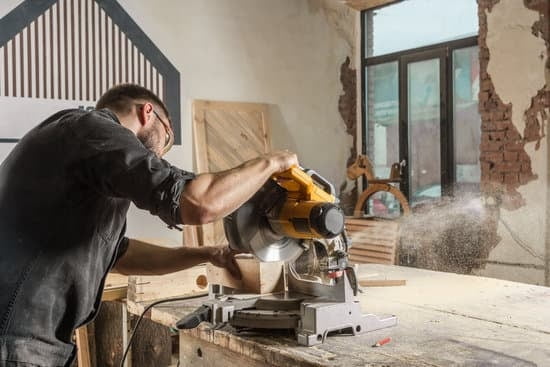What is a dado cut in woodworking? Dado cuts are an essential technique in woodworking that allows for the creation of strong and secure joints, as well as adding decorative elements to a project. In this article, we will delve into the world of dado cuts, covering everything from the basic definition to tips for achieving perfect results.
Dado cuts are grooves or channels cut into the surface of a piece of wood, typically across the grain. These cuts are commonly used to join two pieces of wood together or to insert shelves and dividers into a cabinet or bookcase. Understanding how to make dado cuts and when to use them is crucial for any woodworker looking to create sturdy and visually appealing projects.
In this comprehensive guide, we will break down the process of making dado cuts, including a detailed explanation of what they are and how they are made. We will also discuss the various tools and materials needed for making dado cuts, explore different types of dado cuts and their uses, provide a step-by-step guide, offer expert tips and techniques, showcase real-life examples in woodworking projects, and highlight common mistakes to avoid.
By the end of this article, you will have a solid understanding of dado cuts and be equipped with all the knowledge you need to incorporate them into your woodworking projects successfully.
Understanding Dado Cuts
A dado cut is a woodworking technique that involves cutting a groove or channel across the grain of a piece of wood. This type of cut is commonly used to create joints, such as for shelves in bookcases or cabinets, and provides additional strength and support to the overall structure of the finished project.
Understanding how to make dado cuts is an essential skill for woodworkers of all levels, as it opens up a wide range of design possibilities and allows for the creation of sturdy, long-lasting furniture and other woodworking projects.
What Is a Dado Cut?
In woodworking, a dado cut is a groove or channel that is cut into one piece of wood to receive another piece. This joint provides a strong connection between two pieces, allowing for the assembly of larger structures without the need for additional hardware or fasteners. Dado cuts can be made using a variety of techniques and tools, depending on the specific requirements of the project.
How Are Dado Cuts Made?
Dado cuts can be made using several different methods, including with hand tools such as chisels, as well as power tools like routers and table saws. The most common method involves using a table saw equipped with a dado blade, which is specifically designed to cut wide grooves in wood.
By adjusting the height and width of the dado blade, woodworkers can create precise cuts to accommodate different thicknesses of material. Additionally, dado cuts can also be accomplished using handheld routers fitted with straight bits or spiral bits to achieve clean and accurate results.
Overall, understanding what a dado cut is in woodworking and how it is made is crucial for anyone looking to expand their skills in furniture making or carpentry. With the right tools and techniques, woodworkers can create strong and visually appealing joints that add both structural integrity and aesthetic value to their projects.
Tools and Materials Needed for Dado Cuts
When it comes to making dado cuts in woodworking, having the right tools and materials is crucial for achieving precise and clean results. Whether you are using a table saw, router, or chisel, the right equipment can make all the difference in creating a perfect dado cut. In this section, we will provide a comprehensive list of tools and materials needed for making dado cuts in woodworking.
Essential Tools for Making Dado Cuts
One of the most common tools used for making dado cuts is a table saw. A stacked dado blade set is essential for creating wider dado cuts, while a standard saw blade can be used to create narrower ones.
Additionally, a router with a straight bit can also be used for making dado cuts, especially when working with hardwoods or intricate designs. For those who prefer traditional hand tools, a chisel and mallet can be employed to create dado cuts with precision.
Materials Needed for Making Dado Cuts
In addition to the tools mentioned above, there are several materials that are necessary for making dado cuts in woodworking. This includes the wood that you will be working with, whether it’s plywood, solid wood, or MDF.
Clamps are also essential for securing your workpiece while making the cut, ensuring accuracy and safety. Furthermore, measuring and marking tools such as a combination square or marking gauge are indispensable for laying out the location of the dado cut before making any actual cuts.
Safety Gear
Last but not least, safety gear such as goggles, ear protection, and dust masks should always be worn when working with power tools to make dado cuts. These items are crucial in protecting yourself from potential hazards associated with woodworking activities.
By having the right tools, materials, and safety gear at your disposal, you can ensure that you are well-equipped to tackle any project that requires dado cuts in woodworking.
Types of Dado Cuts
When it comes to woodworking, dado cuts are a versatile and essential technique that allows for strong and precise joinery. There are several types of dado cuts that woodworkers can use depending on the specific needs of their projects. Here are some of the most common types of dado cuts:
1. Through dado: A through dado cut goes completely through the workpiece, creating a slot that runs from one end to the other. This type of dado cut is often used for shelves and dividers in bookcases or cabinets.
2. Stopped dado: Unlike a through dado, a stopped dado cut does not extend all the way through the workpiece. Instead, it stops before reaching the end, leaving a clean and seamless appearance on the surface. Stopped dado cuts are commonly used for creating joinery where the ends of the workpiece are visible.
3. Rabbet-dado joint: This type of joint combines a rabbet cut with a dado cut to create a strong and stable connection between two pieces of wood. The rabbet-dado joint is often used in cabinet making and furniture construction.
Each type of dado cut has its own unique uses and applications in woodworking projects, allowing for flexible and customized joinery solutions.
With an understanding of these different types of dado cuts, woodworkers can choose the most suitable option based on their project requirements, material properties, and desired aesthetics.
Step-by-Step Guide to Making a Dado Cut
Making a dado cut in woodworking involves cutting a groove across the grain of a piece of wood. This type of cut is commonly used to create joints, shelves, and inlays in woodworking projects. Understanding how to make a dado cut is essential for any woodworker, as it allows for strong and seamless connections between wooden pieces. Below is a step-by-step guide on how to make a dado cut with precision:
1. Mark the Location: Use a pencil and measuring tools to mark the location of the dado cut on the wood. Ensure that the markings are accurate and align with your project plans.
2. Set Up Your Tools: Before making the cut, ensure that your table saw or router is securely set up with the appropriate dado blade or bit. Make sure to adjust the cutting depth according to your project specifications.
3. Make the Cut: Carefully feed the wood through the table saw or guide your router along the marked path to create the dado cut. Take your time and maintain steady pressure to achieve a clean and precise cut.
4. Test Fit: Once the dado cut is made, test fit the mating piece to ensure that it fits snugly into the groove without any gaps or misalignments.
5. Fine-tune if Necessary: If adjustments are needed, carefully trim or widen the dado cut as required until you achieve a perfect fit for your woodworking project.
Learning how to make a dado cut is an important skill for any woodworker, as it opens up a wide range of design possibilities and structural options for various woodworking projects. By following these steps, you can confidently create clean and precise dado cuts in your woodworking endeavors.
Tips and Techniques for Perfect Dado Cuts
Making a dado cut in woodworking requires precision and skill to ensure the perfect fit for joints and shelves. It is a groove that is cut across or with the grain of the wood, and it is used to create strong joints or house shelves in cabinetry.
Understanding how to achieve precise and clean dado cuts is essential for any woodworking project. In this section, we will explore some expert tips and techniques to help you achieve the perfect dado cut every time.
One important tip for achieving precise dado cuts is to use the right cutting tools. A table saw with a dado blade or a radial arm saw are commonly used tools for making dado cuts. These specialized blades are designed specifically for creating grooves and can make quick work of cutting accurate dados. Additionally, using a sharp chisel or router plane can help clean up any rough edges left by the saw blade, resulting in a cleaner cut.
Another important technique for achieving clean dado cuts is to properly mark your measurements before making any cuts. Using a marking gauge or combination square, carefully measure and mark the exact location and depth of your dado cut on the wood. Taking the time to accurately mark your cuts will help ensure that you make precise cuts every time.
Furthermore, paying attention to safety measures when making dado cuts is crucial. Always wear safety goggles and follow proper safety protocols when operating power tools such as table saws or routers. Additionally, ensuring that your workspace is well-ventilated and free from clutter can help prevent accidents while making dado cuts.
| Expert Tips | Techniques |
|---|---|
| Use the right cutting tools: table saw with a dado blade | Properly mark measurements before making cuts |
| Use sharp chisel or router plane for cleaning up rough edges | Follow safety measures when using power tools |
Examples of Dado Cuts in Woodworking Projects
Dado cuts are an essential woodworking technique that is commonly used to create strong and seamless joints between two pieces of wood. This type of cut involves removing a channel or groove from the surface of a piece of wood, allowing another piece to fit into it, creating a flush and secure connection. In essence, dado cuts are used to form interlocking joints that enhance the structural integrity of woodworking projects.
One common example of a dado cut in woodworking projects is in the construction of bookshelves. When building a bookshelf, dado cuts are often made in the sides of the shelf where the shelves will be inserted. This creates a sturdy and durable structure that can support the weight of multiple books without warping or collapsing. Additionally, dado cuts are also utilized in cabinet making, particularly for creating strong connections between cabinet sides and shelves.
Another real-life example of dado cuts can be found in the construction of drawers. The grooves made by dado cuts allow for the bottom panel of drawers to slide into place securely, ensuring that they can withstand repeated use without coming apart. Additionally, dado cuts are commonly seen in frames and paneling, where they help to create seamless joints between different sections, resulting in a visually appealing and structurally sound finished product.
It’s important to note that while dado cuts are mainly associated with functional joints and connections in woodworking, they also have aesthetic applications. When done skillfully, dado cuts can add visual interest to furniture and other woodworking projects, providing an opportunity for creative design elements within the piece. Overall, understanding how to make effective dado cuts is crucial for any woodworker looking to produce high-quality and durable pieces.
| Woodworking Project | Application |
|---|---|
| Bookshelves | Creating sturdy connections for shelf support |
| Cabinets | Forming strong joints between cabinet sides and shelves |
| Drawers | Allowing for secure insertion of drawer bottom panels |
| Framing/Paneling | Producing seamless joints for both functional and aesthetic purposes |
Common Mistakes to Avoid When Making Dado Cuts
In conclusion, mastering the art of making dado cuts in woodworking is essential for any woodworker seeking to create strong and seamless joints in their projects. Understanding what a dado cut is and how it is made, as well as having the right tools and materials, is crucial for achieving precise results. By exploring different types of dado cuts and following a step-by-step guide, woodworkers can gain a comprehensive understanding of this technique.
Furthermore, learning from expert advice on tips and techniques for achieving perfect dado cuts can greatly improve the overall quality of woodworking projects. Additionally, real-life examples of dado cuts in various woodworking projects serve as inspiration and guidance for those looking to incorporate this technique into their own creations.
Lastly, being aware of common mistakes to avoid when making dado cuts is just as important as understanding the technique itself. By highlighting these mistakes and providing solutions on how to avoid them, woodworkers can save time and resources while achieving professional-looking results. Ultimately, mastering the art of making dado cuts opens up endless possibilities for creating sturdy and visually appealing furniture pieces, cabinets, shelves, and other woodworking projects.
Frequently Asked Questions
What Is the Difference Between a Dado and a Rabbet Cut?
The main difference between a dado and a rabbet cut lies in their shape and application. A dado is a square-groove joint across the grain, while a rabbet is a right-angled groove along the edge of the wood.
How Is a Dado Cut Useful in Woodworking?
A dado cut is useful in woodworking because it allows for seamless joinery and provides strong support for shelves, dividers, and joints in cabinets, bookcases, and other woodworking projects. It also helps create clean and precise edges when working with wood.
What Is the Purpose of a Dado?
The purpose of a dado is to provide a slot or trench used for joining pieces of wood together, like when constructing shelves or cabinet frames. It also helps in providing more glue surface area for stronger adhesion between the pieces of wood being joined together.

Hi everyone! I’m a woodworker and blogger, and this is my woodworking blog. In my blog, I share tips and tricks for woodworkers of all skill levels, as well as project ideas that you can try yourself.





